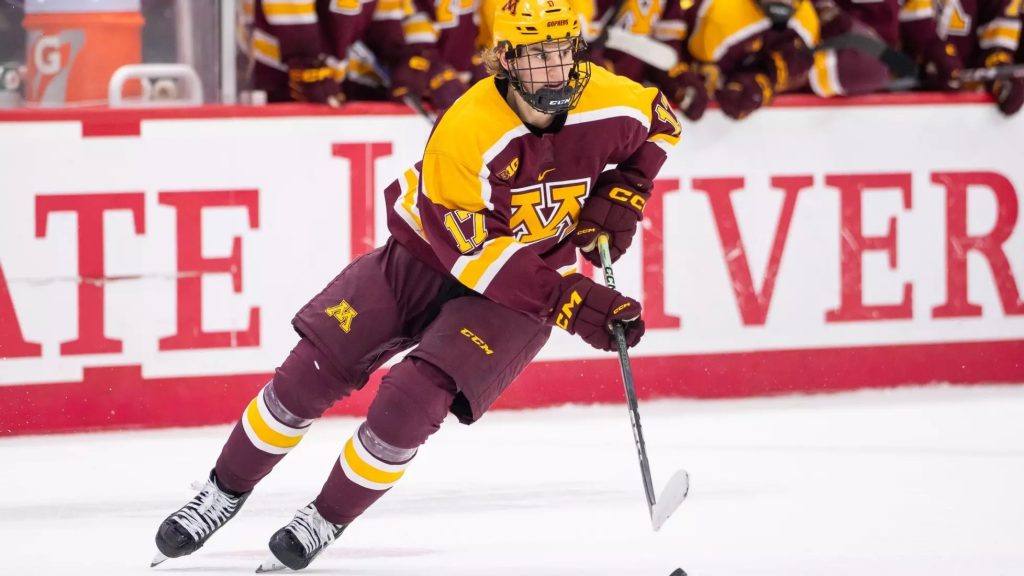
A marathon with potential for a photo finish, run on a treadmill.
That’s what this Big Ten season feels like.
With a month to go before conference playoffs begin, the standings seem to be nearly standing still. Michigan State remains at the top, Ohio State at the bottom, and any movement in between seems nearly negligible – until you take a slightly closer look.
In the second half of the season, B1G teams have played as many as eight conference games and as few as six. Going 5-3 since B1G play resumed in January, the Spartans have earned 15 points. That’s only two more than Minnesota has earned in two fewer games. Everyone else has earned 12 or fewer.
The landscape seems still, but the Gophers are on the move.
“Our team right now is just in a great spot.” That’s what Minnesota coach Bob Motzko told Minnesota play-by-play announcer Wally Shaver this week on the Gophers’ podcast after Minnesota took three of six points from Wisconsin on the road with a win and a tie.
“A lot of times you hear, ‘We’re peaking at the right time,’” said Motzko, “but how we came out of the Michigan State series and as we great during this weekend … we kept growing through the weekend, and Saturday from start to finish, we were dialed in to a player, to a man out there.”
Motzko referred to the “compete level” and “grit,” adding that “it doesn’t happen all the time.”
Minnesota beat Wisconsin 2-1 in overtime Friday on Brody Lamb’s 11th goal of the season – his fourth game winner – at 1:02 of OT.
Saturday’s game ended in a 1-1 tie with Wisconsin picking up the extra shootout point. In regulation in that contest, the Gophers had two goals disallowed – “two horrendous calls,” said Motzko.
At 13:50 in the second period, Ryan Chesley appeared to have scored for Minnesota, but the Badgers challenged the goal, and it was overturned for goaltender interference.
Then at 17:20 in the third, Mason Nevers found the back of the Wisconsin net, but the goal was waved off again for contact with Badgers goaltender Kyle McClellan.
“I thought we deserved a better fate obviously,” said Motzko. “That was the best Gopher game in my six years, from start to finish.”
The Minnesota-Wisconsin series was a second-half offensive outlier for both teams. Both the Gophers and the Badgers have been averaging well above three goals per game this season. The teams combined for five goals total. Neither team scored on one of the five total power-play opportunities in the series.
“Our power play wasn’t what it needed to be this weekend,” said Badgers coach Mike Hastings. The Badgers were 0-for-3 with the advantage against the Gophers. “We had a late power play on Saturday, and I don’t think we got a shot on net, so our execution was off there.”
In the second half of the season, Wisconsin had been held to fewer than three goals once, in the Badgers’ 5-1 loss to Michigan on Jan. 26. Prior to this series, Minnesota had scored fewer than four goals in a second-half game just once, in a 3-2 loss to Michigan State, also on Jan. 26.
The Badgers took the shots to the Gophers Friday, 41-29, with a 21-5 shot advantage in that game’s second period. The Gophers turned those tables Saturday, outshooting the Badgers 43-23.
Motzko said that Minnesota’s greatest challenge now is sustaining this momentum going forward.
“I couldn’t be more proud of our guys, of how this thing is starting to come together with this team, this year,” Motzko said.
Four of Minnesota’s six remaining games are at home, and all are against opponents behind them in the standings and against which the Gophers are 3-2-1 so far for the season.
With 40 points, first-place Michigan State remains five points ahead of Wisconsin and 11 ahead of Minnesota. The Badgers have two games in hand, though, on both the Spartans and the Golden Gophers.
Michigan State and Wisconsin are the only two teams in control of their own fate in terms of a first-place regular-season finish and that first-round Big Ten conference playoff bye. If the Spartans win their six remaining games, the conference is theirs; if the Badgers win seven of their eight, they win the title. The two teams meet to end the season in Wisconsin the first weekend in March.
The middle of the conference standings is so tight that none of the three teams vying for point there – Minnesota (29 points), Notre Dame (27), Michigan (25) – controls its own fate as high as a second-place win, although each is mathematically able to capture the regular-season title.


